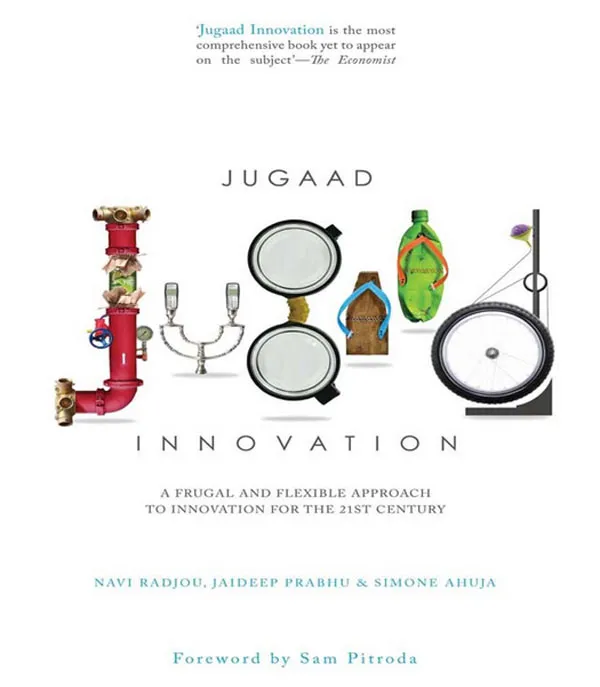[Book Review] Jugaad Innovation: A Frugal and Flexible Approach to Innovation for the 21st Century

URL: http://jugaadinnovation.com/ Amazon: http://amzn.to/PK3wam
2012 Random House India
317 pages; 9 chapters
Leading companies around the world such as GE, Google, PepsiCo, Philips, Renault-Nissan, Siemens, Facebook, Suzlon, Tata Group, and Yes Bank are practising various principles of jugaad or frugal innovation and are learning from grassroots innovators in emerging economies such as India, according to the authors of this informative book. These principles are also being adopted by many NGOs and governments around the world.
Though many in India would argue that jugaad is not just frugal or flexible innovation but sometimes also a makeshift workaround or ‘bandage’ solution and not true innovation, this term seems to have stuck and is finding acceptance in Western business jargon as well. But even for those who do not attach a romantic or positive connotation to jugaad, this book offers six useful principles of frugal and flexible innovation, and two practical chapters on scaling these principles from the individual to the organisational and national levels.
Jugaad innovation is less like Western classical music and more like jazz (an analogy I like, considering I am also a jazz RJ/editor!). I have summed up these principles of innovation, along with some sample examples, in Table 1 below. Some of these principles may apply to bottom-up or customer-centric innovation in general, and not just jugaad.
Table 1: Principles of Jugaad Innovation
“Innovation is going to be critical for India – not only for growth and competitive advantage, but also to ensure our future development is sustainable and inclusive,” according to Sam Pitroda, chairman of India’s National Innovation Council. The innovations need to manage with scarce resources, and be affordable and environmentally sustainable. “Today we are a nation of a billion connected people,” says Pitroda, and this will change industry, education and government in India.
Jugaad thrives in environments which are harsh, politically and economically unstable, bureaucratic, culturally diverse, with poor infrastructure and inadequate access to finance and skilled human resources. But this requires companies to see the proverbial half-empty glass as half-full.
The authors show that the ‘jugaad’ model also exists in other countries under different names, eg. zizhu chuangxin (in China) and Systeme D or Systeme Debrouillard (in France). “Jugaad was once a big part of Western innovation too,” according to the authors, who cite Benjamin Franklin and the Wright brothers as jugaad innovators.

Unfortunately this spirit seems to have been lost as Western corporations institutionalised innovation and standardised processes for all activities including creativity. But in today’s fast-moving world with economic upheavals coupled with agile entrepreneurs, the structured approach to innovation is too expensive, resource consuming, inflexible, elitist and insular.
The authors caution that jugaad should not replace but complement existing structured innovation practices in big companies. Companies also need to be able swing between these two kinds of innovation practices, rather than find an elusive balance in the middle. The authors cite GE Healthcare as a good example of a company which integrates Six Sigma along with jugaad, eg. its MAC portable and affordable ECG devices, Vscan portable ultrasound scanners. Other companies such as IBM, HCL and TCS have effectively used social media to organise massive and intensive brainstorming sessions.
The authors end with an intriguing list of university and government initiatives for building ‘jugaad nations.’ I have summarised them in Table 2 below.
Table 2: Government, University and Global Initiatives for the Jugaad Movement
Notable trends identified in the book include the disruptive innovations emerging from software startups and services. “Silicon Valley entrepreneurs – and startups in high-tech hotpots like Bangalore, Chennai and Pune – are targeting marginal segments that have long been ignored by brick-and-mortar companies in capital-intensive sectors such as healthcare, telecom, finance, education and energy,” the authors explain.
In sum, this is an informative and interesting read for all those involved in innovation and entrepreneurship in emerging economies and the global impacts of such innovation models.
Author profiles:
Navi Radjou is the Executive Director of the Centre for India & Global Business at the Judge Business School at the University of Cambridge. He is a strategy consultant to leading organizations worldwide, and has published a 10-part report series titled India: The Innovation Giant (Re) Awakens.
Jaideep Prabhu is the Jawaharlal Nehru Professor of Indian Business and Enterprise and Director of the Centre for India & Global Business at the University of Cambridge. He has consulted with or taught executives from top tier companies around the world.
Simone Ahuja is the Founder and Principal of Blood Orange Media, a vertically integrated media company based in Minneapolis, USA. Her company Blood Orange, develops, produces and distributes non-fiction television programs in genres that include travel, history, and business, and develops concepts for fiction programming.
About Madanmohan Rao
Madanmohan Rao is research director at YourStory Media and editor of five book series.


![[Book Review] Jugaad Innovation: A Frugal and Flexible Approach to Innovation for the 21st Century](https://images.yourstory.com/cs/wordpress/2012/09/jugaad_innovation.jpg?mode=crop&crop=faces&ar=16%3A9&format=auto&w=1920&q=75)




